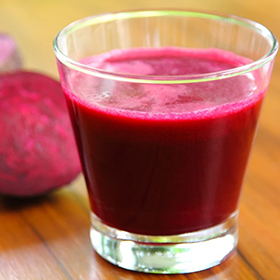
The reason I call it the blood pressure smoothie is all of the ingredients have been shown in many scientific studies to reduce blood pressure. By no way is this meant to replace advice from you GP but you can share it with them and see if they are interested in preventing the problem rather than just treating it with pharmaceuticals. Remember also that I am not a GP I am just the guy who does all the research which is why I have a PhD.
4 ingredients in order of importance
Beetroot
Almonds (soaked for at least 8 hours)
Linseed (flaxseed)
Filtered re-mineralised ionized water.
Extras for taste and minerals
Banana
Coconut
Dates
Start by grinding the linseed and the almond in the smoothie maker.
Add the beetroot and the filtered water to make up to the constituency you need.
If you want to make it a bit sweeter add some ripe banana, dates or coconut water (and coconut meat if you have the whole coconut) as they are rich in Potassium (and other minerals) which is essential for muscle relaxation and tastes great. But wait till the banana is ripe for the best taste. You can also cold green tea instead of water to add to the antioxidant mix.
The properties that make this smoothie such a potent blood pressure mix is all of the ingredients have excellent antioxidant properties, rich in minerals and other nutrients liked with lowering blood pressure in scientific studies.
Background
High blood pressure or hypertension is having a blood pressure reading of above of around 90mm Hg on 140mm Hg. Hypertension itself is not a disease but a condition or as an indicator of ‘increased risk’ of cardiovascular disease. Patients who are hypertensive have an increased risk of heart attack and stroke due to the direct correlation between the two. Hypertension also contributes significantly to the increased risk of kidney failure and other chronic illness.
In healthy people the cells of blood vessels produce the substance called nitric oxide (NO) which instructs smooth muscles surrounding arteries to relax. If they cant relax they stay rigid and you end up with high blood pressure. The NO is produced in a single layer of cells that line the inside of the arteries called the endothelium. If this tissue is damaged in the case of too much pressure, oxidation or through other means it stops producing NO and blood pressure rises.
Many of the beneficial actions of nutrition on lowering blood pressure results both directly and indirectly through improving endothelial tissue and NO production and release from this tissue. Two major pathways to increase NO are increase the rates of nitrates in the diet, the building block for NO, and L-Arginine which stimulate the enzyme to manufacture NO. Endothelial-derived NO also inhibits platelet adhesion, activation, secretion, and aggregation and promotes platelet disaggregation so you are less likely to have a stroke. A third mechanism that is absolutely critical is to protect and repair the endothelium, remember it is only one cell thick and very susceptible to damage. Vitamin C and antioxidants are essential for this part.
Diets high in dietary nitrate such as beetroot are associated with reduced blood pressure increased exercise performance as a result of vasodilation (expansion) of the blood vessels and a decreased incidence in cardiovascular disease. 100-200mg of beetroot per day has been shown to produce immediate effects of lowering blood pressure by around 15 mm of Hg. Beetroot is also rich in vitamins, phytochemicals and contains large amounts of iron and folic acid Mg, Na and Ca. Apart from the nitrates the major bioactive molecules in beet are polyphenols, flavonoids, betalains, therapeutic enzymes, ascorbic acid, and dehydroascorbic acid (DHAA). So they not only provide the ingredients for NO production but also help in repair and protection of the endothelium.
Almonds have one of the highest sources of L-Arginine (most nuts have lots of L-Arginine so you can substitute the almonds if you want) which stimulates NO synthesis. Studies of almonds have shown reductions of 5-6 mm of blood pressure. It is important to soak the almonds as they (all nuts and seeds) have enzyme-inhibiting factors in them which stop them from germinating until they have enough water. These enzyme inhibitors also stop the absorption of some nutrients, particularly minerals. When you soak the nuts many of the nutrients also become more available for digestion.
Flaxseed is rich in Omega 3 fatty acids, L Arginine (about 20% less than almonds), lignans, antioxidants and fiber that together probably provide benefits to patients with cardiovascular disease. Studies on consuming 30g of flaxseed have been shown to reduce blood pressure by up to 15 mm Hg.
The great thing about this smoothie is that you can add just about anything else you want to it and it will make it even tastier and better for you.